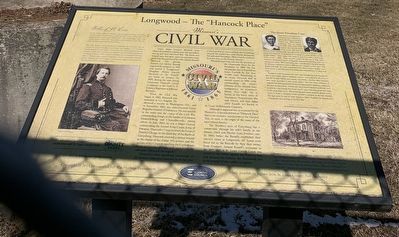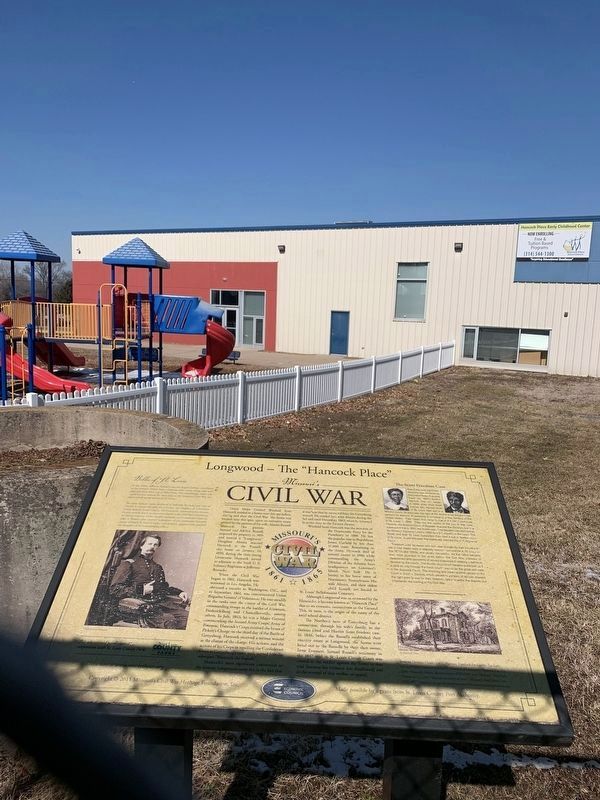Lemay in St. Louis County, Missouri — The American Midwest (Upper Plains)
Longwood — The "Hancock Place"
— Missouri's Civil War —
Belles of St. Louis
In the 1820s , Jefferson Barracks was the largest military installation in the western United States, Consequently, many young men were stationed there fresh out of West Point,. Not surprisingly, many who would become famous for there roles in the American Civil War met and married young women of St. Louis.
The most famous union produced at Jefferson Barracks was that of Ulyesses S Grant and Julia Dent Grant, the daughter of a Southern family from St. Louis County. "The Hancocks" relationships has become famous as well, due to an extensive subplot in the 1993 film Gettysburg by Turner Pictures. Other notable examples are Confederate Generals Jordan S. who married a daughter of the prominent Kennerly family of South St. Louis County and James Longstreet,who married the daughter of his commanding officer.
Union Major General Winfield Scott Hancock resided in a home near this site before, during and after the Civil War. This home was located near this spot, upon an extensive estate owned by the parents of his wife, Almira Russell Hancock. Her parents, Samuel and Adeline Russell, acquired the property in 1855 and named it "Longwood. Daughter Almira married Hancock at the Russells' city home on January 24, 1850 during the time young Lieutenant Hancock served as adjutant to the Sixth U. S. Infantry Regiment at Jefferson Barracks.
When the Civil War began in 1861, Hancock was stationed Los Angeles. He obtained a transfer to Washington D. C. and in September, 1861, was commissioned Union Brigadier General of Volunteers. He rose steadily in the ranks over the course of the Civil War, commanding troops in the battle of Antietam, Fredericksburg and Chancellorsville, among others. In July, 1863, he was a Major general commanding, the Second Army Corps. Army of Potomac. Hancock's Corps received the brunt of Pickett's Charge on the third day of the Battle of Gettysburg. Hancock received a serious wound at the climax of the charge. His action, and the actions of his Corps in repelling the Confederate forces at Gettysburg's stone wall, earned him the sobriquet "Hancock the Superb."
Hancock's most significant connection to the historic Longwood estate lies in the fact that it was here he recovered from his Gettysburg wound. He resided here with Almira during the fall and until December, 1863, when he returned to active duty in the Eastern theater.
Winfield Scott Hancock was the nominee of the Democratic Party for the Presidency in 1880. He lost the popular vote to Republican James Garfield by less than 10,000 votes. Remaining in the Army. Hancock died of natural causes in1886 while commanding the Army's Division of the Atlantic from headquarters on Governor Island, New York. He is buried in his home town of Norristown, Pennsylvania. His wife Almira and their oldest child Russell are buried St. Louis' Bellefontaine Cemetery.
Although Longwood was never owned by the Hancocks, it became known as "Hancock Place due to its extensive connection to the General. This in turn, is the origin of the name of the local school district.
The Northern hero of Gettysburg has a connection, through his wife's family to the famous Dred and Harriet Scott freedom case. In 1846 before Russells established their country estate at Longwood, the Scotts were hired out to the Russells by their then owner, Irene Emerson, Samuel Russell's testimony in the 1847 trail in St. Louis Circuit Court was central to the verdict against the Scotts in that trail (because his evidence was disallowed0 and to the reversal of that verdict on appeal.
The Scott Freedom Case
One of the most significant decisions ever rendered by the United States Supreme Court was 1857's Scott v . Sanford. The suit began in 1846 when Dred Scott and his wife Harriett Scott of St. Louis filed suit in a Missouri court. At issue was the right of the Scott's to be declared freepersons on account of residence in bondage in a free territory of the United States. The case first came to trail in the Old Court House in St. Louis in 1847. They lost the verdict of the jury in that case . However , the Missouri Court of Appeals reverted the decision and in a subsequent trail in 1850 the Scotts won. This decision was reversed by the Missouri Supreme Court in 1852 by a 2 - 1 majority on the court. The Scotts and their St. Louis supporters then filed a suit in federal court in St. Louis. It was this case that eventually reached the U. S. Supreme Court.
"Freedom suits" by slaves who had been brought by their masters to live in free states were a relatively common occurrence in St. Louis in The 1830s and 1840s, and usually successful. As the nation became ever more polarized in the years before the Civil War interest of slave owners and opponents of slavery coalesced in seeking a definitive decision by the courts. The Scotts' case which became politicized as if wound its way through the the lower courts, was to be the greatest test case in the Supreme Court. The shocking and mean - spirited opinion of the Court in Scott v Sanford, which denied to person of African descent the right even to sue for their freedom, failed to settle the dispute, but it hasten the coming of the Civil War.
Erected 2011 by Saint Louis County Parks.
Topics and series. This memorial is listed in these topic lists: African Americans • War, US Civil • Women. In addition, it is included in the Missouri’s Civil War series list.
Location. 38° 31.945′ N, 90° 16.621′ W. Marker is in Lemay, Missouri, in St. Louis County. Memorial is at the intersection of Vincent Avenue and South Broadway Street (State Road 231), on the right when traveling west on Vincent Avenue. Touch for map. Marker is in this post office area: Saint Louis MO 63125, United States of America. Touch for directions.
Other nearby markers. At least 8 other markers are within walking distance of this marker. Veterans Memorial (approx. ¼ mile away); Jefferson Barracks Historic Site North Gate (approx. 0.8 miles away); a different marker also named Jefferson Barracks Historic Site North Gate (approx. 0.9 miles away); Jefferson Barracks Historic Site - World War II Reception Center #1772 (approx. 0.9 miles away); French Settlement (approx. 0.9 miles away); Missouri Military Memorial (approx. 0.9 miles away); A Longstanding, Strategically Central Military Post (approx. 0.9 miles away); Jefferson Barracks - At the Confluence of American History (approx. 0.9 miles away). Touch for a list and map of all markers in Lemay.
Also see . . . Missouri’s Civil War. Missouri’s Civil War Heritage Foundation (Submitted on March 4, 2022.)
Credits. This page was last revised on March 4, 2022. It was originally submitted on March 2, 2022, by Thomas Smith of Waterloo, Ill. This page has been viewed 387 times since then and 55 times this year. Photos: 1, 2. submitted on March 3, 2022, by Thomas Smith of Waterloo, Ill. • Bernard Fisher was the editor who published this page.

